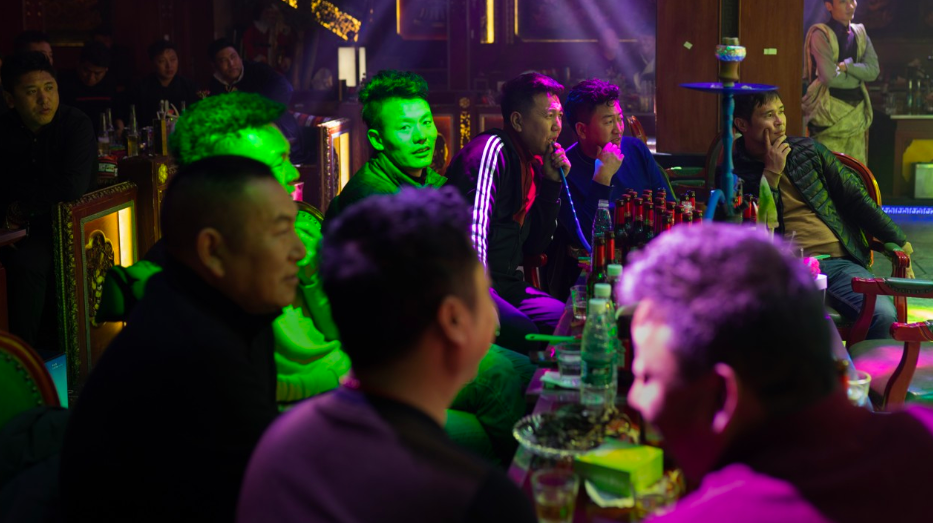My eye opening encounters with Tibetan youths inside Tibet
By Vijay Kranti
(This article is the latest in Vijay Kranti’s ongoing series ‘My Journey Through the Tibetan Mindscape’ in Phayul.com. Author is a senior Indian journalist, a veteran Tibet watcher and Chairman Centre for Himalayan Asia Studies and engagement. This is his 50th year of association with Tibet.)
The worst fear of a journalist while working on a news story is about being taken for a ride by some interested party and thereby ending up with presenting their propaganda and narrative through that news story. When I started writing on Tibet about five decades ago, I too was many times skeptical about the authenticity of the information I would receive about the human rights conditions inside Tibet through my Tibetan contacts. Normally it used to be either a press release or a news item from ‘Tibetan Review’ or, on some occasions, some recent escapees who were introduced to me by the Information Office of the Central Tibetan Administration. Then there were published accounts of some western travelers and journalists who could manage to travel to Tibet for one or other reason. But every time I went through these accounts, my professional desire to counter check or verify these accounts and the frustration of not being able to do so would only keep growing and piling up.
Unfortunately in those days China had put Tibet under an iron lock and very few individuals could visit this Chinese colony even under strict Chinese supervision. Beijing would occasionally take some foreign journalists on conducted tour of Tibet but it was beyond imagination of a journalist of my (dis)reputation to win smiles of the Chinese embassy in New Delhi. Later in mid 1980s too when China’s ‘Paramount Leader’ Deng Xioping announced that “To get rich is glorious” and pulled out every plug to earn touro-dollars from Tibet by popularizing it as a tourist destination, the prices were too high for a journalist of my financial status. It was much later when my earning levels improved and the flood of tourists to Tibet also made me feel safer that I started taking the plunge. In journeys that followed took me to the ‘Tibet Autonomous Region’ and all the four Chinese provinces namely Yunnan, Sichuan, Qinghai and Gansu in which the Chinese masters of Tibet have absorbed remaining parts of original Tibet.
Obviously, besides having a close look at Tibet’s life under China’s colonial controls other things of most interest to me were to fathom the commitment of ordinary Tibetan people towards Tibet and their own Tibetan identity. And of course their opinion and attitude towards their Chinese masters. An overwhelming presence of Chinese police, other uniformed forces and plain clothe agents in every street, village, town and city of Tibet and blatant installation of hundreds of cameras along 360 degree of view from any point in a public place is surely enough to instill a sense of fear in any local person or even a visitor from abroad. But still I can say that despite the prevailing fear of being watched one could still find some Tibetans who would communicate their anger and resistance against the Chinese masters in one or other way.
In any temple or monastery this resistance is loudly visible in the form of an abnormal heap of ‘Khatags’ (holy scarves) at the feet of a vacant throne which once belonged to the absent Dalai Lama. If you have the eye to catch it, this public denouncement of Beijing’s rulers by ordinary Tibetans is too visible to miss on the Barkhor street of Lhasa where the photos of the ‘Gyamie’ (Chinese) or the ‘Zuma’ (fake) Panchen Lama is missing among a pile of posters of Chairman Mao and so many Tibetan gurus simply because no one buys his photos in spite of heavy patronage of the Chinese rulers to him.
But what impressed me more than anything during my nearly 5000 km travels inside ‘Cholka-Sum’ i.e. the original Tibet, was the show of this resistance against the Chinese presence and pride in the Tibetan identity at one of the most unlikely places – the ‘Nangma’ which is the Tibetan dance bar or discotheque or night club where Tibetan youths meet every evening. Unlike the Chinese Karaoke bars that offer every kind of music and, may be, sex escapades too to an ever increasing population of Han settlers, the Tibetan ‘Nangma’ is a different kind of experience oozing with beer, music, dance and social life. As a part of the traditional social and cultural life of any Tibetan town the ‘Nangma’ is one of those few social institutions which have survived the onslaught of colonial rule of China. I am not sure about the villages but there is hardly any town of city in today’s Tibet which does not boast of a lively Nangma. On my first ever visit to Tibet when I went to a ‘Nangma’ of Lhasa with a fellow European tourist and his Tibetan friend who also helped us with some explanations in his not so perfect English, I was disappointed, rather somewhat shocked, to see Tibet missing from the young Tibetans who were there to enjoy the evening. Most of them looked Tibetan only in their looks. All dressed in smart jeans, T-shirts and in the case of girls — provocative dresses, attractive makeup and loud perfumes too. Only the ‘Nangma’ staff girls, boys and some among the performing singers and musicians of the evening were identifiable from their colourful Tibetan costumes. One could easily make out that most of the guests looked financially comfortable because only a Tibetan who could pay for the entrance ticket and rounds of beer could afford to be a part of such a colourful party. As a long term admirer of Tibet and Tibetan people, I was wondering if the new Tibetan generation in Tibet had bartered its Tibetness with comfortable jobs in Chinese establishments or some private business.
A ‘Nangma’ would come to life late in the evening when Tibetan girls and boys, mostly in the 14-40 age group, start pouring in twos, fours and even a groups of dozen at a time. Soon they were all spread over the hall around traditional colourful Tibetan tables of carved wood. There were quite a few large groups where beer bottles would land up in boxes and emptied soon amid bouts of laughter and cheers. But there was surely no shortage of tables where only cold drinks and mineral water were the preferred drinks. In my later visits to the ‘Nangma’ of other cities, the scene would be almost same. The dance floor would become active amidst a flood of laser beams, crystal lights and dry ice fog during the intervals between live performances. The hall is quickly filled with suffocating cigarette smoke as smoking still stays as a dominant habit among Tibetans.
On most such evenings the show would start with a formal ‘Tashi Delek!’ welcome song by a young male singer as it happened during my first visit to ‘Nangma’ in Lhasa. Sung in Tibetan, the good-luck wishing song attracted a long scarf from the management and many cheers from the crowd for the singer. But the first formal presentation was a politically correct song which was in praise of Beijing government and the Chinese Communist Party for all those good things they had done to Tibet. I was told that such songs are compulsory to be played in such gatherings. I noticed that there was not a single clap for the singer. No cheering, no scarves either. But things changed dramatically on the next song when the same singer presented a traditional Tibetan love song that filled the hall with loud applause. The singer received two scarves from two admirers in the crowd in addition to one from the management. There were some solo and group songs with traditional Tibetan music which were in praise of Tibet’s rivers, Snow Mountains, monasteries, valleys and clean air. Each such song drew wild applause and scarves from the audience. It was then I realized that many Tibetans were carrying one or two neatly folded scarves in the hip pocket of their jeans to present to the singers of their choice. In between these Tibetan songs there were a couple of Chinese language songs too which showered praise on the Chinese government for improving the environment and making Tibetan peoples’ lives ‘happy’. Again, no clapping, no scarves.
But the real show stopper of the evening was a young Nepalese dancer girl who presented some popular Bollywood Hindi songs. Borrowing the name of ‘Madhuri Dixit’ whose popularity was at peak in those days she had dressed up in a colourful Indian Saree and an overdone make up. Although she looked like a poor imitation of the Indian heroin yet her dance on real sound tracks of songs like ‘Ek Do Teen’ and ‘Chal Jhoothi’ stole the hearts of the Tibetan audience — men and girls included. The musical beats of the Hindi songs pulled all the plugs and drowned the hall in claps, cheers, whistles and – many scarves from the audience. On another similar evening in Dartsedo I was surprised to notice some high ranking Chinese military officers in the audience and enjoying Tibetan music and dance along with their staff members.
It happened more than once that when some Tibetan young boys and girls noticed me in the audience of the ‘Nangma’ and discovered that I had come from India, quite a few of them would quietly come to me for a handshake or a hug and leave some bottles of beer and cold drinks on my table. At one town near Lithang when a young Tibetan found quite a few bottles of beer landing on my table he quietly came to me, gave me a hug and whispered in my years in a patronizing voice in best of his English, “I love India. But you no drink beer. Beer bad. No good, no drink”.
During my visits to many ‘Nangmas’ and short meetings with some popular and not so popular singers I realized that many among these Tibetans had produced innocent looking but politically quite meaningful songs like ‘Agu Pema’ (Uncle Pema) which became very popular among the ordinary Tibetans. But these songs quickly disappeared before the Chinese authorities could understand the real political message behind these songs. This particular song which looks like one sung in the memory of a lost dear uncle, was actually dedicated to the exiled Dalai Lama who is also revered as ‘Pema’ (meaning ‘Lotus’) among the Tibetans.
It was only after being a part of many ‘Nangma’ audiences in about a dozen Tibetan towns and cities and being a firsthand witness to the zeal, courage and commitment of Tibetan youths, did the message sank into my heart that the Tibetan-ness of the young Tibetans may or may not reflect from the dresses they wear, but it did shine forcefully through their choice of clapping or not clapping for a song.
(Views expressed are his own)
The author is a senior journalist, photographer and a Tibetologist – now in the 50th year of his love affair with Tibet. This article is the latest in his ongoing series “My Journey Through the Tibetan Mindscape” in PHAYUL since July, 2020.
+91-9810245674 v.kranti@gmail.com











7 Responses
Vijay Kranti sees things through a journalist’s eyes and is able to see things ordinary folks can’t. My family and I had the good fortune to visit Tibet in 2010, just after the Beijing Olympics. My relatives in Lhasa took us to see the “Nangma” there. Reading Vjay’s article brings back fond memories of that night in Lhasa.
At that time I did not see the subtle things that were going on, but I saw Chinese military personal coming and going to ensure that everything including the songs were politically correct and that no untoward views of Tibetan Independence were being expressed.
As an older Tibetan I agree with Vijay’s view that the younger generation in and out of Tibet may adapt to the Hollywood way of life, but in the inside they are very much Tibetan. So long as our spirit continues to live in our younger generation, Tibet will always live on and be FREE one day.
BOD GYALO!
In the trans-Himalayan region, the dichotomy between Chinese and Indian influence is palpable. There needs to be a balance between economic advancement and basic rights. In past centuries, there was a clear advantage of geographic separation by the mountains. With that gone, people of the region should be aware that the choice is not just Indian or Chinese ideology. People ultimately determine the society that is acceptable to the most. So when there is mass resettlement, that changes the demographics. It’s not that dissimilar to KMT resettlement in Taiwan or migration patterns in Crimea of Tatars or resettlement of Rohingyas.
What is obvious are these are real people and their lives. Not to be trivialized by “breaking news” with short term memory. Until humanity learns to accept that, we really should question what purpose our large cerebral cortex serves compared to that of other vertebrates.
is white european civilization really more progressive and democratic than the Nalanda university treachings on basic equality of all sentient beings? I thought gender and sexuality debate in the west is a small subset of the larger holistic set of Buddhist cause which dictates all sentient beings being equal which includes male and female, black and white, animals and homo sepiens, basically all dichotomies.
Vijay Kranti’s piece on Tibetan identity is interesting..While the older people keep their culture , traditions, customs, language intact, the young generation keeps its identity alive, despite their vulnerable , impressionable mind which is highly inclined to be influenced by things new, untested , tempting….you have clearly noticed the restlessness , helplessness, and smouldering dislike for the Chinese in the Tibetan youth…This sustains hope among the Tibetans living outside their homeland and also to the outside world that Tibet will become again a free land one day..
Dear Vijay,
Your article is good but not relevant. We Tibetans are now focussed on domestic absuse and feminism thanks to western education. We woke up. We realized how backward our Nalanda inspired attitudes in gender and sexuality is based on European white peoples ideas.
Tibetan feminists educated in Western universities have started a more important and urgent cause than Tibetan survival against Chinese invasion and forced adoption of Han way of looking at the world.
Whilst Tibetan both men and women’s human rights is important, more important is denial of Tibetan women’s human right committed by violent perpetrator Tibetan men, while those violent men are fighting as armies against the Chinese men and women.
So Vijay kranti must write in more urgent issue of Tibetan inter-refugee, inter-family issues in diaspora focusing on America-made women’s empowerment instead of Tibetan empowerment suffering under Chinese occupation.
I am sure Ukrainian women are rising up against denial of human rights by their husbands and fathers who represent toxic patrial force which subjugates women. Even Mr Putin might declare Ukrainian women as opposed by Ukrainian society and that russian invasion could liberate women from harm by males, just as Chinese did in 1959, as intervention from outside for benevolent non-profit safeguarding purposes.
In case you are really a Tibetan and really believe that Tibetans are ‘backward’ because of their traditional Nalanda inspired attitudes and that they should rely on the western education and should focus more on issues related to feminism than the national resistance against colonialism, then YOU are the right candidate to learn from those brave Tibetan youths who, despite all risks involved in challenging their Chinese colonial masters, have the courage to decide when to clap and when not to. Respecting women and their rights is very much essence of Nalanda, Indian and Buddhist traditions. Their followers don’t need special education from the western societies who themselves have lost the distinction between collective welfare and rights of the society vis-a-vis exclusive rights of an individual (including criminals and terrorists). About your judgement that this article is “GOOD BUT NOT RELEVANT” qualifies you to be the right beneficiary of my prayers for some wisdom to you. However, I would be happy to believe that you made this comment only out of sarcasm and fun and don’t mean it seriously.
However, I would be happy to believe that you made this comment only out of sarcasm and fun and don’t mean it seriously.
In case you are really a Tibetan and really believe that Tibetans are ‘backward’ because of their traditional Nalanda inspired attitudes and that they should rely on the western education and should focus more on issues related to feminism than the national resistance against colonialism, then YOU are the right candidate to learn from those brave Tibetan youths who, despite all risks involved in challenging their Chinese colonial masters, have the courage to decide when to clap and when not to. Respecting women and their rights is very much essence of Nalanda, Indian and Buddhist traditions. Their followers don’t need special education from the western societies who themselves have lost the distinction between collective welfare and rights of the society vis-a-vis exclusive rights of an individual (including criminals and terrorists).
I respect your right to make judgement that this article is “GOOD BUT NOT RELEVANT” — even if it hurts.